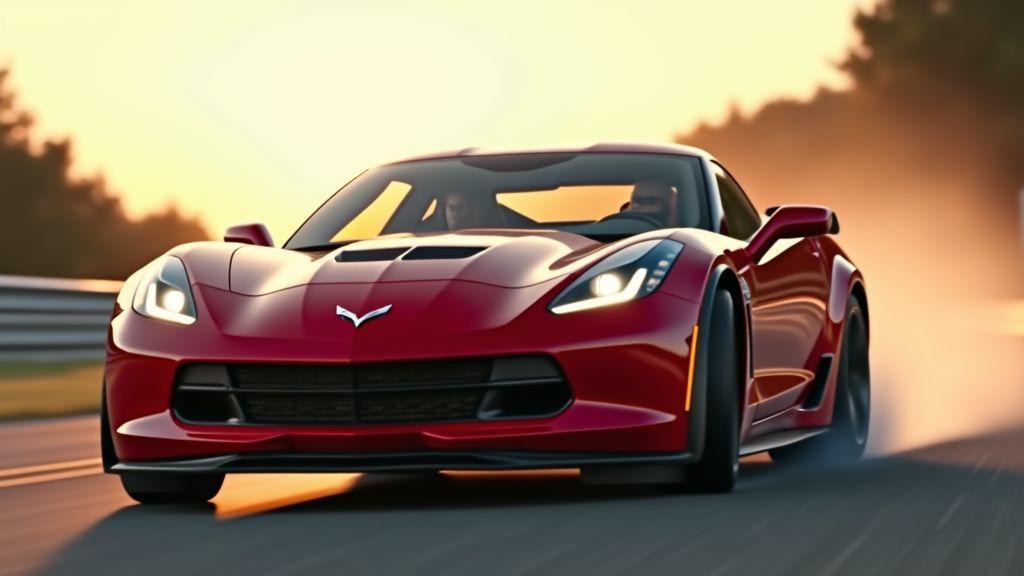Top 5 Sports Cars with the Best Handling
Top 5 Sports Cars with the Best Handling gives you a clear guide to judging steering, grip, and chassis dynamics so you can pick cars that feel sharp and balanced. You will learn what steering feedback tells you, how to read lap times and lateral g, and a quick checklist to compare top handling cars. Get the lowdown on active suspension, LSDs, and chassis tuning, plus the role of tires, brakes, and aero. You’ll know how to read spec sheets, weigh street comfort versus track focus, and what to test on a short drive with a simple test route to judge handling.
Key Takeaway
- You feel precise, quick steering
- Your car stays stable in corners
- You get strong grip from tires and suspension
- Your brakes are sharp and predictable
- You benefit from balanced weight and a low center of gravity

How you evaluate handling with steering, grip, and sports car chassis dynamics
You judge a sports car’s handling first by how the steering talks to you. Sit in the driver’s seat and feel how the wheel weights up, how it centers, and how small inputs change the car’s line. Good steering gives clear, steady signals about grip and road surface. When you can sense tire bite and slip through the wheel, you can drive faster with confidence. For deeper theory, see the Fundamentals of vehicle dynamics and handling.
Next, look at grip and how the car responds under load. Grip comes from tires, suspension setup, and weight distribution. Push the car through a sweep or a quick direction change. If it stays planted and recovers predictably, you’ve got a setup that lets you extract speed without surprise. If it snaps or feels vague, braking and throttle corrections will be harder and slower.
Chassis dynamics tie steering and grip together. Pay attention to roll, pitch, and how weight shifts when you brake, turn, or accelerate. A well-balanced chassis keeps changes gradual so you can place the car on the road like a pencil on paper. You want a car that forgives small mistakes and rewards smooth inputs with faster lap times and more fun on twisty roads.
What steering feedback tells you about sports car feel
Steering feedback reveals how connected you are to the car. If the wheel gives steady, proportional information, you know when the front tires are close to losing traction. That lets you reduce input gently and keep control. Cars with vague steering force you to guess, which costs time and raises stress.
Feel also shows how the steering is tuned. Heavy, numb, or overly light steering can hide problems. A light, try-hard wheel may feel quick but leaves you blind to limits. A firm, clear wheel tells you exactly how hard you can push. Think of steering feedback as a conversation; the better the talk, the better your lap.
Measuring cornering: lap times, lateral g, and cornering data
Measure cornering both in raw data and in behavior lap after lap. Lap times give a simple score, but consistency matters more than a single fast lap. A car that posts repeatable lap times without surprises shows predictable cornering. Use consistent tires, the same fuel, and a steady driver to compare fairly.
Lateral g tells you how much grip the car makes. Use a g-meter and look for high but usable peak g and stable mid-corner numbers. Tire temps, pressure, and chassis balance decide how that g is produced. When you read reviews or lists such as the ones on the Meridian Pioneer home page, check both lap times and g/consistency data to see which cars actually hold the line.
| Metric | What it shows | How you measure |
|---|---|---|
| Lap time | Overall speed and driver confidence | Timed laps on same track/config |
| Lateral g | Peak and sustained cornering grip | G-meter or telemetry |
| Consistency | Predictability over multiple laps | Lap time spread & tire temp trend |
Quick checklist you can use to compare top handling sports cars
Use this short list as your pre-drive cheat sheet to compare cars:
- Steering feel: is it clear, heavy, or vague?
- Onset and recovery: does the car settle predictably after corrections?
- Grip source: tires, balance, or aero—where does it come from?
- Consistency: do lap times and tire temps stay steady?
- Driver confidence: do you want to push harder or back off?
How key technologies make sports cars with superior handling feel sharper
You feel the difference the moment you turn in. Modern handling tech turns vague steering into crisp intent. Active systems read the road and react faster than your hands can, so corners feel precise. That sharpness is a mix of fast-acting suspension, torque control, low weight, and clear steering feedback. When the car reacts cleanly, you trust it—and trust lets you push harder and enjoy driving more. See Research on vehicle systems and dynamics for studies on suspension and control systems that inform modern handling.
Think of these systems as a muscle team: some parts absorb bumps, some move power where you need it, and others keep the car flat and planted. That teamwork removes surprises and makes mid-corner corrections tiny. The result: a car that changes direction like it’s answering a question you didn’t finish asking. You’ll notice better lap times, calmer highway transitions, and safer emergency lane changes.
If you look at lists like Top 5 Sports Cars with the Best Handling, you’ll see similar patterns: the best models mix mechanical hardware and smart electronics in the right amounts. Electronics should add control without dulling the road. That balance creates a sharper, more honest connection between you and the tarmac.
Active suspension, LSDs, and chassis tuning that create handling-focused sports cars
Active suspension controls body motion in real time. It can stiffen for a track lap and soften for a bumpy road, reducing roll and keeping the tires in contact with the road.
Limited-slip differentials (LSDs) move torque between wheels to fight understeer or oversteer. Mechanical LSDs give a simple, reliable feel; electronic torque-vectoring splits power more precisely. Chassis tuning—stiffness, bushings, and mounting points—sets the baseline. Tight mounts give sharp response; softer mounts can make a car feel vague.
These systems must work together. If the chassis is loose, even the best LSD can’t save the feel. When tuning is right, the car snaps to line and holds it: immediate steering response and cleaner mid-corner exits.
Tires, brakes, and aero: the hardware behind best handling performance cars
Tires are the final link to the road. Compound, width, and profile shape grip and response. Low-profile tires give sharp turn-in but a firmer ride. Sticky compounds bite harder but wear faster—trade longevity for lap time. Official guidance on tire condition and pressure can be found in resources like How tires affect vehicle handling.
Brakes manage weight transfer and stopping performance. Big rotors resist fade on track; a firm, linear pedal lets you brake later with confidence. Aero keeps the car planted at speed: splitters, wings, and underbody flow add downforce and balance. More downforce means higher cornering force, but also more drag. The best hardware mixes grip, fade resistance, and aerodynamic balance so you can push without surprises. For regulatory and technical context on aerodynamic devices, see the Aerodynamics and technical regulations overview.
How you read spec sheets to spot the best handling sports cars
Start with these core specs and compare them like a checklist:
- Curb weight and weight distribution (lower and closer to 50/50 is better)
- Suspension type and adjustability (adaptive dampers, sway bar setup)
- Differential type (mechanical LSD vs. electronic torque vectoring)
- Tire size and recommended compound (performance tires listed)
- Brake rotor diameter and caliper type (multi-piston preferred)
- Steering ratio and whether it’s hydraulic or electric assist
- Any listed downforce or aero package details
Read the numbers, then imagine how they work together. A light car with basic aero can still out-handle a heavier car with flashy electronics. Use the checklist to spot cars that match how you drive.

How the Top 5 Sports Cars with the Best Handling compare for street and track
You want a car that feels alive on a twisty road and calm on a Sunday cruise. The Top 5 Sports Cars with the Best Handling will each lean one way or the other: some trade ride comfort for razor-sharp turn-in, others soften the edges for daily use. Thinking in terms of steering feel, suspension tuning, and brake feedback helps you pick the right compromise.
On the street you care about ride quality, low-speed manners, and noise levels. On the track you prize quick response, high lateral grip, and predictable limits. The same car can feel cozy on your commute but turn into a scalpel once you push it. Knowing how a model balances those traits tells you whether it matches your goals.
| Attribute | Street priority | Track priority |
|---|---|---|
| Suspension | Comfort, bump absorption | Stiff, controlled body roll |
| Steering | Light at low speed, stable feel | Heavy, direct, high feedback |
| Tires | Longevity, wet grip | Sticky compound, heat tolerance |
| Brakes | Fade resistance, smooth modulation | High bite, cooling, repeatability |
| Cabin | Noise and comfort | Minimal weight, driver focus |
Street comfort versus track focus in an agile sports cars review
Street-tuned sports cars are forgiving: softer springs, more insulation, and steering that helps you place the car without constant correction. That makes for a relaxed yet engaging commute.
Track-focused cars reward precision and punish hesitation. You’ll feel every input, but the car responds instantly. Expect firmer seats, stiffer springs, and less sound dampening so you can hear and feel what matters—tire slip, brake balance, and throttle bite. If you love the limit, that raw honesty is addictive.
What you should test on a short drive when choosing top five best handling cars
Start with basics and work up to stops and corners. Feel the steering at low speed, then at a brisk pace. Check how the car settles over a bump and how it recovers on the next turn. Pay attention to brake feel: does it bite where you expect or feel dead at first? The Sports Car Club of America provides driver curricula and practical on-track training you can use to shape your test routine: Driver training and on-track testing checklist.
Follow this short checklist on your drive:
- Low-speed steering feel and parking maneuvers
- Ride over bumps and mid-corner composure
- Brake modulation and initial bite
- Throttle response and traction out of corners
- Noise, vibration, and general comfort for daily use
A simple test route you can use to judge sports cars with superior handling
Pick a 10–20 minute loop that mixes a quiet backroad with a stretch of sweepers and one short technical section of tight turns. Start slow to assess comfort, then increase pace on the sweepers to feel balance and grip. Finish with a few hard stops and quick lane changes to judge brakes and steering precision. This short, repeatable loop lets you compare cars back-to-back with clear notes.
Top 5 Sports Cars with the Best Handling — quick examples
To give context to the checklist and tech discussed, here are five cars commonly praised for handling (examples only — test each against the criteria above):
- Porsche 911 GT3 — precise steering, superb balance, track-capable chassis
- Alpine A110 — lightweight, excellent balance, playful handling
- Mazda MX-5 Miata — light, communicative steering, rewarding for the limits
- Toyota GR86 / Subaru BRZ — balanced chassis, great steering feedback for the price
- BMW M2 (or similar compact M car) — strong mechanical grip and chassis tuning
Conclusion
You now have a clear playbook to judge a sports car’s steering, grip, and chassis dynamics. Look for crisp steering feedback, predictable brake bite, and consistent lap times and lateral g. Check the spec sheet for weight distribution, suspension type, LSD or torque-vectoring, and tire recommendations. These are the building blocks that turn a good car into one that feels alive.
When you test drive, use the checklist and the simple test route. Start slow to assess ride and low-speed manners. Push into sweepers to feel balance and mid-corner character. Watch for repeatability more than a single fast lap. Think of the car as a team: active suspension, chassis tuning, and aero should work together, not fight each other. The best setups feel like a conversation—clear, useful, and confidence-building.
In short: trust your hands, your eyes, and your notes. Favor consistency and honest feedback over flashy numbers. If you want more practical guides, comparisons, and deep dives, keep reading at Meridian Pioneer home page — there’s more rubber-burning insight waiting for you.
If you have specific questions or want to arrange a test drive, contact the Meridian Pioneer team to get in touch.
For information on how we handle data and site use, see our privacy policy and terms of use.

